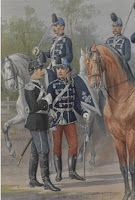Post-Napoleonic (Russo Turkish War Era) Russian Hussars Complete
In this post, dear readers, we report on the completion of the previous work in progress post: two units of Russian Hussars for my Russo Turkish War Era Russian Army. For full particulars of this project, please follow the link to the previous post. By way of brief summary here, this was an almost 100 percent conversion, with all bits either modified or coming from different kits/manufacturers:
The figures began life as Perry Carlist War Polish/Foreign Legion Lancers (above), with their headgear modified into small form kepis with plume, hussar details painted onto the uniforms, rearmed with swords from Gripping Beast, and mounted on spare horses (probably Perry Prussian napoleonic) from among my bits box. I'm not sure if "kitbashing" is something limited to plastics or not, but it would probably apply here, I'm thinking.
I decided on representing the 11th (left) and 6th Hussars. I used the NYPL uniform collection and paintings by Pyotr Balashov as primary guides.
I decided on representing the 11th (left) and 6th Hussars. I used the NYPL uniform collection and paintings by Pyotr Balashov as primary guides.
Here is a study of the finished units. As usual, you may clix pix for BIG PIX in this post.
11th Hussars
Given that the figures are in short jackets, I painted in the part of the hussar attila that would extend below the belt. The figs are in lancer girdles, which I painted in as hussar barrel sashes. The rest of the hussar rig was painted in, to include my Home Made Hungarian Knots.
6th Hussars
6th Hussars
I was quite taken by the 6th's unique combination of dark blue uniform, white distinctions, and light blue kepi.
I was a bit concerned about how the Gripping Beast swords would work, size-wise, but in the end they turned out fine. The original swords, being medieval, only had cross hilts. I painted over the ball of J-B Qwik Weld used to hold them in place to represent the full cavalry hilts.
Both Units at Table View Distance
Another set of conversions joins the lists of my Post-Napoleonic collection.
Another set of conversions joins the lists of my Post-Napoleonic collection.
Next up: Russian Uhlans!





















Ed, your hussars are gorgeous! Love the coloring with light blue, white, and yellow. Magnificent!
ReplyDeleteThanks, Jonathan: the military fashion of the mid/late 19th century armies, pre-khaki, really did hit a high point.
DeleteStunning work Ed!
ReplyDeleteThanks, Ray: now to get them onto a table!
DeleteGreat job on these conversions. They look fantastic! 😀
ReplyDeleteThanks, Stew. It's always a value-added moment when you plunk them on the table and someone asks what they think is a simple question, like "Who makes those?"
DeleteI agree! The French and Austrians from the FAW are some of my favorites.
ReplyDeleteSplendid conversion work and painting! My conversion work is largely limited to plastic, I do enjoy looking at figures and thinking what else I can get out if them!
ReplyDeleteBest Iain
Thanks, Iain. Initially, it's stubborness (and maybe a bit of frustration) that motivates me to embark on a conversion: nobody makes the figure I need. Having said that, there is a positive side that associated with the creative process that kicks in shortly thereafter.
DeleteLovely looking Hussars Ed...
ReplyDeleteCertainly well worth the effort...
All the best. Aly
Thanks, Aly. Rounding the bend on the uhlans next...
DeleteAccidentally visiting this page, I am really surprised that there are people who are interested in the Russian uniforms of this period. As a historical consultant who knows all about these Russian uniforms...
ReplyDeleteOn the march, the Russian hussars, like the rest of the cavalry, looked very different from what we see in the presented watercolor references. Most of the hussars were caps instead of shakos. Plumes were worn only during a parade and on few other occasions. Shakos were never covered with cloth. Light blue or white "covers" didn't exist. If they were worn on the campaign, they were covered with black tarpaulin cover with yellow squadron number on the front (ex.: "1Э." (1st squadron), "2Э.", "3Э.", "4Э."), same for the uhlans. Speaking of uhlans, they had a different helmet - model 1869. Shabraques weren't used on a campaign by the regular cavalry at all. Officer horses had no rear or front saddle straps and the horses of the lower ranks only had a single frontal breast strap. Only the officer horses had a badge on the cords on their foreheads. Officers' cartridge boxes, saber harnesses, saddles - were different and were all worn differently, as well as many other parts of the equipment.
What the cavalry did use were eight axes per squadron and copper cavalry mess-kits on the left of valises. If these hussars are shown in full dress, which, I suppose, looks like it, then even then the uniforms are unfortunately inaccurate. But in general, given how little information is available on this topic, the work is impressive and done well.
Thanks for dropping by and providing your input, Roman. As you mention, information is scanty, to say the least, about anything other than cossacks for this era. And certainly no Post Crimean figure line (that I know of) offers any Russian cavalry other than cossacks (and certainly none that would fit anything like the descriptions you outline--much is the pity!). I would certainly have preferred to work with a line of actual, accurate, Imperial Russian cavalry figures rather than cobbling together all these conversions :). For what it's worth, I did show my research and the decisions I made along the way (for better or worse). And I do own up to some choices that I realize would be more parade field than battlefield--guilty as charged!
Delete